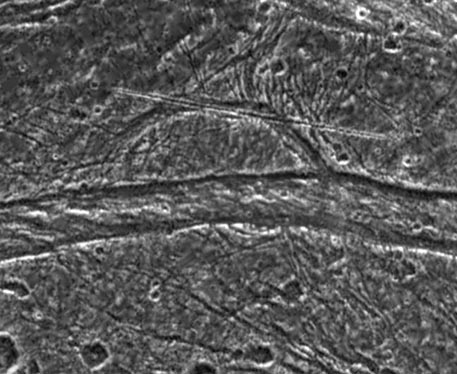Credit & Copyright: The Galileo Project,
NASA
Explanation:
Where is the rest of the circle? Jupiter's largest moon
Ganymede has some truly unusual terrain,
including the pictured half circle above cut by nearly parallel curves.
Full circles can be easily explained by
impact craters,
but partial circles imply that some resurfacing has
occurred since the original impact.
The diameter of the half circle is about 32 kilometers.
Also of interest is a dense linear
crater chain
that cuts across the top of the half-circle.
Mysteries like these are typically solved by the
hard work of reconstructing a sequence of natural occurrences,
which in this case may yield a better understanding of
Ganymede's interesting past.
1999 2000 2001 2002 2003 2004 2005 2006 2007 2008 2009 2010 2011 2012 2013 2014 2015 2016 2017 2018 2019 2020 2021 2022 2023 2024 2025 |
Yanvar' Fevral' Mart Aprel' Mai Iyun' Iyul' Avgust Sentyabr' Oktyabr' Noyabr' Dekabr' |
NASA Web Site Statements, Warnings, and Disclaimers
NASA Official: Jay Norris. Specific rights apply.
A service of: LHEA at NASA / GSFC
& Michigan Tech. U.
|
Publikacii s klyuchevymi slovami:
Ganymede - Ganimed - krater
Publikacii so slovami: Ganymede - Ganimed - krater | |
Sm. takzhe:
Vse publikacii na tu zhe temu >> | |
